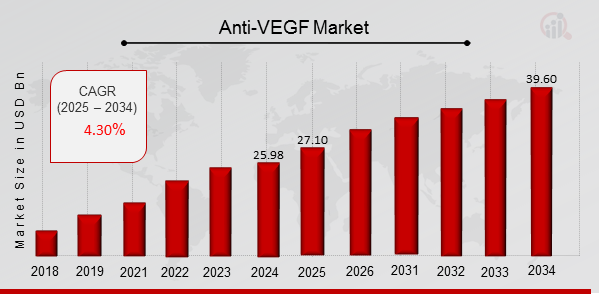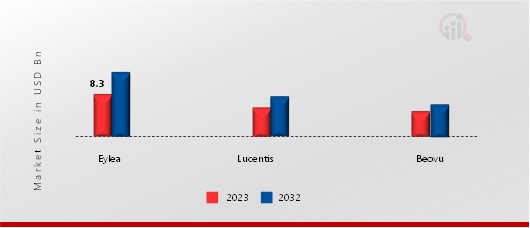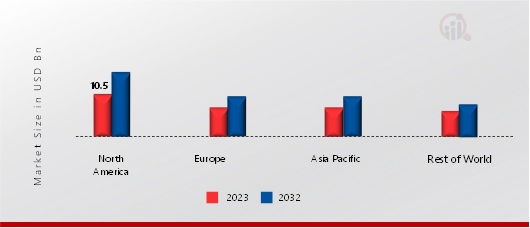Anti VEGF Market Summary
As per MRFR Analysis, the Anti-VEGF Market Size was estimated at 25.98 USD Billion in 2024 and is projected to grow from 27.10 USD Billion in 2025 to 39.60 USD Billion by 2034, at a CAGR of approximately 4.30% during the forecast period. Key drivers include increased screening rates leading to more diagnoses of retinal diseases, advancements in biotechnology, and rising incidence of conditions like age-related macular degeneration (AMD) and diabetic retinopathy (DR). Eylea dominated the market in 2023, accounting for 35% of revenue, while Lucentis is experiencing the highest CAGR. North America holds the largest market share, followed by Europe and Asia-Pacific, which is expected to grow at the fastest rate.
Key Market Trends & Highlights
The Anti-VEGF market is witnessing significant growth driven by awareness and technological advancements.
- Market Size in 2024: USD 25.98 Billion
- CAGR from 2025 to 2034: 4.30%
- Eylea accounted for 35% of market revenue in 2023
- Lucentis is experiencing the highest CAGR in the market
Market Size & Forecast
2024 Market Size: USD 25.98 Billion
2025 Market Size: USD 27.10 Billion
2034 Market Size: USD 39.60 Billion
CAGR (2025-2034): 4.30%
Largest Regional Market Share in 2023: North America
Major Players
Regeneron Pharmaceuticals, Novartis AG, Roche, Bayer AG, Allergan plc, Pfizer Inc., Bausch Health Companies Inc., AbbVie Inc., Santen Pharmaceutical Co., Ltd., Alcon Inc.
As per MRFR analysis, the Anti-VEGF Market Size was estimated at 25.98 (USD Billion) in 2024. The Anti-VEGF Market Industry is expected to grow from 27.10 (USD Billion) in 2025 to 39.60 (USD Billion) till 2034, at a CAGR (growth rate) is expected to be around 4.30% during the forecast period (2025 - 2034). Increased screening rates result in more patients being diagnosed with retinal diseases are the key market drivers enhancing the market growth.

Source: Secondary Research, Primary Research, MRFR Database and Analyst Review
Anti-VEGF Market Trends
- Growing awareness and screening programs are driving market growth
Market CAGR for Anti-VEGF is being driven by the growing awareness and screening programs. Public health initiatives and educational campaigns raise awareness about the signs, symptoms, and risk factors of conditions such as age-related macular degeneration (AMD) and diabetic retinopathy (DR). Increased awareness encourages individuals to undergo regular eye screenings, leading to the identification of retinal diseases at earlier stages when treatment with Anti-VEGF therapies is most effective. Additionally, screening programs ensure that patients receive timely referrals to ophthalmologists and retina specialists for diagnosis and treatment, further driving the demand for Anti-VEGF drugs. By promoting proactive healthcare-seeking behavior and improving access to early intervention, growing awareness and screening programs contribute to the expansion of the Anti-VEGF market and ultimately improve patient outcomes.
Advancements in biotechnology and drug delivery are significant drivers of the Anti-VEGF market, revolutionizing the treatment landscape for retinal diseases. Innovative technologies have enabled the development of next-generation Anti-VEGF therapies with improved efficacy, durability, and safety profiles. Novel drug formulations and delivery methods, such as sustained-release implants and longer-acting agents, offer extended treatment intervals and reduce the burden of frequent injections for patients. Additionally, targeted drug delivery systems allow for precise drug localization within the eye, maximizing therapeutic effects while minimizing systemic side effects. These advancements enhance patient adherence to treatment regimens and improve overall treatment outcomes. Moreover, ongoing research in biotechnology continues to uncover new therapeutic targets and pathways, paving the way for the development of novel Anti-VEGF drugs with enhanced potency and specificity, further driving the growth of the Anti-VEGF market.
The rising incidence of retinal diseases, such as age-related macular degeneration (AMD), diabetic retinopathy (DR), and retinal vein occlusion (RVO), is a significant driver of the Anti-VEGF market. As the global population ages and the prevalence of conditions like diabetes increases, the incidence of retinal diseases continues to rise. These conditions often involve abnormal blood vessel growth in the retina, leading to vision loss and impairment. Anti-VEGF therapies target vascular endothelial growth factor (VEGF), a key driver of abnormal blood vessel growth, to inhibit angiogenesis and preserve vision. With an increasing number of individuals affected by retinal diseases, there is a growing demand for Anti-VEGF treatments to manage these conditions effectively. Consequently, the expanding patient population drives market growth and fosters innovation in Anti-VEGF therapies. For instance, Regeneron Pharmaceuticals, Inc. revealed that the United States Food and Drug Administration (FDA) has agreed to review the supplemental Biologics License Application (sBLA) for EYLEA (aflibercept) Injection, focusing on the 16-week 2 mg dosing regimen (following initial monthly doses) for individuals with diabetic retinopathy (DR).
Anti-VEGF Market Segment Insights
Anti-VEGF Product Insights
The Anti-VEGF Market segmentation, based on product, includes Eylea, Lucentis, and Beovu. In 2023, the Eylea segment dominated the market, accounting for 35% of market revenue due to its proven efficacy, extended dosing interval, and versatility in treating various retinal diseases. Clinical studies have demonstrated Eylea's effectiveness in improving visual outcomes and reducing disease progression in conditions such as age-related macular degeneration (AMD), diabetic retinopathy (DR), and macular edema. Additionally, its less frequent dosing regimen, compared to some competitors, offers convenience for both patients and healthcare providers, contributing to its widespread adoption and dominance in the market.
Lucentis (ranibizumab) is experiencing the highest compound annual growth rate (CAGR) in the Anti-VEGF market due to several factors. Its well-established efficacy and safety profile in treating retinal diseases such as age-related macular degeneration (AMD) and diabetic retinopathy (DR) contribute to its increasing adoption. Additionally, ongoing clinical research and development initiatives exploring new indications and treatment regimens for Lucentis drive market growth. Moreover, strategic pricing and reimbursement strategies enhance its accessibility and affordability, further fueling its growth trajectory in the Anti-VEGF market.
Figure 1: Anti-VEGF Market, by Product, 2023 & 2032 (USD Billion)

Source: Secondary Research, Primary Research, MRFR Database and Analyst Review
Anti-VEGF Disease Insights
The Anti-VEGF Market segmentation, based on disease, includes Macular Edema, Diabetic Retinopathy, Retinal Vein Occlusion, and Age-Related Macular Degeneration. In 2023, the Macular Edema category generated the most income due to its high prevalence and significant impact on vision. Conditions such as diabetic macular edema (DME) and macular edema secondary to retinal vein occlusion (RVO) affect a large patient population worldwide. Anti-VEGF therapies are the standard of care for managing macular edema, as they effectively reduce fluid accumulation in the macula, improve visual acuity, and prevent disease progression, driving their widespread use and dominance in the market.
Diabetic retinopathy (DR) is experiencing the highest compound annual growth rate (CAGR) in the Anti-VEGF market due to several factors. The rising prevalence of diabetes worldwide, particularly in developing countries, contributes to the increasing incidence of DR. Additionally, growing awareness about the importance of regular eye screenings for diabetic patients and advances in diagnostic techniques lead to earlier detection and intervention. Furthermore, the expanding treatment options, including Anti-VEGF therapies, for DR drive market growth by improving patient outcomes and reducing the risk of vision loss.
Anti-VEGF Regional Insights
By region, the study provides the market insights into North America, Europe, Asia-Pacific, and the Rest of the World. North America has secured the largest market share in the Anti-VEGF market due to several factors. The region benefits from a well-established healthcare infrastructure, high healthcare expenditure, and advanced diagnostic and treatment capabilities. Additionally, a large patient population affected by retinal diseases, such as age-related macular degeneration (AMD) and diabetic retinopathy (DR), drives the demand for Anti-VEGF therapies. Furthermore, favorable reimbursement policies, robust research and development activities, and the presence of key market players contribute to North America's dominance in the Anti-VEGF market.
Further, the major countries studied in the market report are the US, Canada, Germany, France, the UK, Italy, Spain, China, Japan, India, Australia, and South Korea.
Figure 2: Anti-VEGF Market Share By Region 2023 (USD Billion)

Source: Secondary Research, Primary Research, MRFR Database and Analyst Review
Europe Anti-VEGF market accounts for the second-largest market share due to the high prevalence of retinal diseases. Europe has emerged as the second-largest market for Anti-VEGF therapies due to several factors. The region boasts a well-developed healthcare system with widespread access to advanced medical technologies and treatments. Additionally, the high prevalence of retinal diseases, such as age-related macular degeneration (AMD) and diabetic retinopathy (DR), drives the demand for Anti-VEGF therapies. Furthermore, supportive regulatory frameworks, favorable reimbursement policies, and robust clinical research contribute to Europe's significant market share in the Anti-VEGF market. Further, the German Anti-VEGF market held the largest market share, and the UK Anti-VEGF market was the fastest growing market in the European region.
The Asia-Pacific Anti-VEGF Market is expected to grow at the fastest CAGR from 2025 to 2034. The Asia Pacific region is experiencing the highest compound annual growth rate (CAGR) in the Anti-VEGF market due to several factors. These include the increasing prevalence of retinal diseases such as age-related macular degeneration (AMD) and diabetic retinopathy (DR) due to aging populations and rising diabetes incidence. Additionally, improving healthcare infrastructure, growing awareness about retinal diseases, and expanding access to innovative treatments drive market growth in the Asia Pacific region, making it a key area for investment and expansion in the Anti-VEGF market. Moreover, China’s Anti-VEGF market held the largest market share, and the Indian Anti-VEGF market was the fastest growing market in the Asia-Pacific region.
Anti-VEGF Key Market Players & Competitive Insights
Leading players In the Anti-VEGF market, Regeneron Pharmaceuticals, Novartis AG, Roche (Genentech), and Bayer AG are focusing on strategic initiatives to maintain and strengthen their market positions. These initiatives include research and market development efforts to develop novel Anti-VEGF therapies, expansion of product portfolios through acquisitions and partnerships, and geographical expansion to tap into emerging markets. Additionally, these companies are investing in marketing and educational campaigns to increase awareness and adoption of their Anti-VEGF products.
Manufacturing locally to minimize operational costs is one of the key business tactics used by manufacturers in the global Anti-VEGF industry to benefit clients and increase the market sector. In recent years, the Anti-VEGF industry has offered some of the most significant advantages to eylea. Major players in the Anti-VEGF market, including Regeneron Pharmaceuticals, Novartis AG, Roche, Bayer AG, Allergan plc, Pfizer Inc., Bausch Health Companies Inc., AbbVie Inc., Santen Pharmaceutical Co., Ltd., Alcon Inc., and Others, are attempting to increase market demand by investing in research and development operations.
Regeneron Pharmaceuticals, a leading biotechnology company, is a key player in the Anti-VEGF market. The company's flagship Anti-VEGF therapy, EYLEA (aflibercept) Injection, is approved for the treatment of various retinal diseases, including age-related macular degeneration (AMD), diabetic macular edema (DME), and macular edema following retinal vein occlusion (RVO). EYLEA has established itself as a standard-of-care treatment due to its efficacy, safety, and extended dosing intervals. Regeneron continues to invest in research and development to expand the indications and improve the formulations of its Anti-VEGF therapies. Additionally, strategic partnerships and collaborations further strengthen Regeneron's position in the Anti-VEGF market, allowing the company to maintain its leadership and drive innovation in the treatment of retinal diseases.
Novartis AG, a global pharmaceutical company, is a major player in the Anti-VEGF market. The company's Anti-VEGF portfolio includes Lucentis (ranibizumab), a widely used treatment for retinal diseases such as age-related macular degeneration (AMD) and diabetic retinopathy (DR). Lucentis is administered via intravitreal injections and has demonstrated efficacy in improving visual outcomes and preventing disease progression. Novartis continues to invest in research and development to expand the indications and formulations of Lucentis, as well as to develop novel Anti-VEGF therapies. Additionally, the company leverages its strong global presence and marketing capabilities to ensure broad market access for its Anti-VEGF products, solidifying its position as a key player in the Anti-VEGF market.
Key Companies in the Anti-VEGF market include
- Bausch Health Companies Inc.
- Santen Pharmaceutical Co., Ltd.
Anti-VEGF Industry Developments
February 2022: REGENXBIO Inc. disclosed further encouraging interim findings from its ongoing Phase II ALTITUDE trial assessing RGX-314 for treating diabetic retinopathy (DR) without center-involved diabetic macular edema (CI-DME), employing in-office suprachoroidal delivery.
January 2022: The Food and Drug Administration granted approval to Roche for Vabysmo, an eye disorder medication indicated for wet age-related macular degeneration, a condition that could lead to vision loss in older individuals.
Anti-VEGF Market Segmentation
Anti-VEGF Product Outlook
Anti-VEGF Disease Outlook
Anti-VEGF Regional Outlook
| Report Attribute/Metric |
Details |
|
Market Size 2024
|
25.98 (USD Billion)
|
|
Market Size 2025
|
27.10 (USD Billion)
|
|
Market Size 2034
|
39.60 (USD Billion)
|
|
Compound Annual Growth Rate (CAGR)
|
4.30 % (2025 - 2034)
|
|
Report Coverage
|
Revenue Forecast, Competitive Landscape, Growth Factors, and Trends
|
|
Base Year
|
2024
|
|
Market Forecast Period
|
2025 - 2034
|
|
Historical Data
|
2020 - 2024
|
| Report Coverage |
Revenue Forecast, Market Competitive Landscape, Growth Factors, and Trends |
| Segments Covered |
Product, Disease, and Region |
| Geographies Covered |
North America, Europe, Asia Pacific, and the Rest of the World |
| Countries Covered |
The US, Canada, Germany, France, UK, Italy, Spain, China, Japan, India, Australia, South Korea |
| Key Companies Profiled |
Regeneron Pharmaceuticals, Novartis AG, Roche, Bayer AG, Allergan plc, Pfizer Inc., Bausch Health Companies Inc., AbbVie Inc., Santen Pharmaceutical Co., Ltd., Alcon Inc. and Others |
| Key Market Opportunities |
· Development of Long-Acting Formulations and Investment in Research and Development |
| Key Market Dynamics |
· Growing Awareness and Screening Programs and Advancements in Biotechnology and Drug Delivery |
Frequently Asked Questions (FAQ) :
The Anti-VEGF Market size was valued at USD 23.9 Billion in 2023.
The global market is projected to grow at a CAGR of 4.30% during the forecast period, 2025-2034.
North America had the largest share in the global market.
The key players in the market are Regeneron Pharmaceuticals, Novartis AG, Roche, Bayer AG, Allergan plc, Pfizer Inc., Bausch Health Companies Inc., AbbVie Inc., Santen Pharmaceutical Co., Ltd., Alcon Inc., and Others Company.
The eylea category dominated the market in 2023.
Macular edema had the largest share in the global market.

















